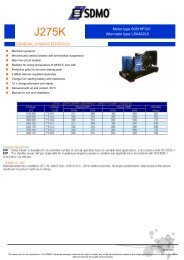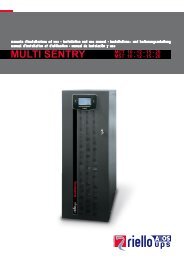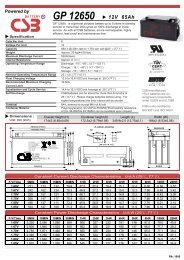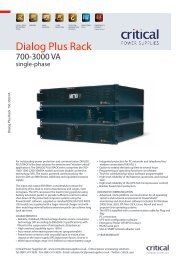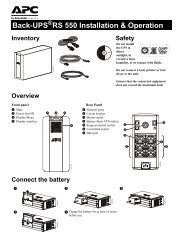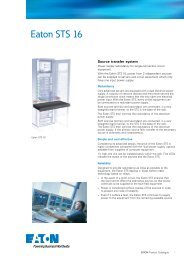User manual V5.0 for the Advanced SNMP/Web ... - GE Digital Energy
User manual V5.0 for the Advanced SNMP/Web ... - GE Digital Energy
User manual V5.0 for the Advanced SNMP/Web ... - GE Digital Energy
You also want an ePaper? Increase the reach of your titles
YUMPU automatically turns print PDFs into web optimized ePapers that Google loves.
<strong>GE</strong>Consumer & IndustrialOperating Manual<strong>Digital</strong> <strong>Energy</strong>ADVANCED <strong>SNMP</strong>WEB INTERFACE CARD( <strong>for</strong> firmware version 1.84 or higher )SG Series 10 - 500 / 400VAC CE / 480VAC ULSitePro 10 - 500 kVA / 400VAC CESitePro A 10 - 300 kVA / 208-480VAC ULLP 33 / 10, 20 & 30 kVA / 400VAC CE / Series 4LP 33 / 10 & 20 kVA / 208VAC UL / Series 1<strong>GE</strong> Consumer & Industrial SAGeneral Electric CompanyCH – 6595 Riazzino (Locarno)SwitzerlandT +41 (0)91 / 850 51 51F +41 (0)91 / 850 51 44www.gedigitalenergy.com
ModelADVANCED <strong>SNMP</strong> / WEB INTERFACE CARDDate of issue: 01.02.2007File name:Author:OPM_CNT_ADV_SNM_CRD_XGB_V050Lorenzo GiuntiniRevision: 5.0Identification No. 11701Up-datingRevision Concerns Date3.1 General review <strong>for</strong> UL and new layout 15.06.20044.0 Without BNC, new layout and company name changes (<strong>GE</strong>) 06.12.20045.0 Introduction of PMAD functionality 12.12.2006Table of contentsPage1 CONTENT OF THE KIT.........................................................................................................................................................................................32 INTRODUCTION ....................................................................................................................................................................................................43 SPECIFICATION .....................................................................................................................................................................................................54 INSTALLATION.......................................................................................................................................................................................................65 REMOVE ...................................................................................................................................................................................................................96 CONFIGURATION METHODS........................................................................................................................................................................ 106.1 CONFIGURATION OVER THE NETWORK ............................................................................................................................................................. 106.2 CONFIGURATION VIA A SERIAL CONNECTION................................................................................................................................................. 107 CONFIGURATION OPTIONS .......................................................................................................................................................................... 118 USE.......................................................................................................................................................................................................................... 178.1 <strong>SNMP</strong> A<strong>GE</strong>NT.................................................................................................................................................................................................................. 178.2 WEB SERVER................................................................................................................................................................................................................... 178.2.1 Login and UPS Identification web page.............................................................................................................................................................................. 178.2.2 UPS Details web page.................................................................................................................................................................................................................. 208.2.3 UPS Alarms web page ................................................................................................................................................................................................................. 218.2.4 UPS Tests web page ..................................................................................................................................................................................................................... 228.2.5 UPS Control web page................................................................................................................................................................................................................. 248.2.6 UPS Configuration web page................................................................................................................................................................................................... 258.2.7 Agent Configuration web page............................................................................................................................................................................................... 268.2.8 Trap Configuration web page.................................................................................................................................................................................................. 278.2.9 Special Functions web page..................................................................................................................................................................................................... 289 UPDATE FIRMWARE......................................................................................................................................................................................... 299.1 UPDATE FIRMWARE USING TELNET OR SERIAL LINE.................................................................................................................................... 299.2 UPDATE FIRMWARE USING WEB BROWSER..................................................................................................................................................... 3010 SUPPORTED MIB VARIABLES ....................................................................................................................................................................... 3111 SUPPORT .............................................................................................................................................................................................................. 32COPYRIGHT © 2007 by <strong>GE</strong> Consumer & IndustrialAll rights reserved; reproduction without permission prohibited.This <strong>manual</strong> may be subject to change; no liability can be accepted <strong>for</strong> any error or omission.Modifications reserved Page 2/33OPM_CNT_ADV_SNM_CRD_XGB_V050.docOperating Manual ADVANCED <strong>SNMP</strong> / WEB INTERFACE CARD
1 CONTENT OF THE KITThe advanced <strong>SNMP</strong> Card is delivered with <strong>the</strong> following material:<strong>User</strong> ManualSpecial note <strong>for</strong>SitePro installation<strong>Advanced</strong> <strong>SNMP</strong> CardIM0025Smaller front panel <strong>for</strong>SitePro and SG Series UPSSquare plates andscrews <strong>for</strong> olderSitePro UPSModifications reserved Page 3/33OPM_CNT_ADV_SNM_CRD_XGB_V050.docOperating Manual ADVANCED <strong>SNMP</strong> WEB INTERFACE CARD
2 INTRODUCTIONWARNING !The work to be done is reserved to Service engineers which have been previouslytrained on <strong>the</strong>se UPS's, and <strong>the</strong>re<strong>for</strong>e have thorough knowledge about <strong>the</strong>function and handling of this equipment.IntroductionThe <strong>SNMP</strong>/<strong>Web</strong> Interface is designed to present in<strong>for</strong>mation about <strong>the</strong> UPS on <strong>the</strong> network.The interface provides <strong>the</strong> UPS in<strong>for</strong>mation in two ways:• <strong>SNMP</strong> AgentThe <strong>SNMP</strong> in<strong>for</strong>mation complies to <strong>the</strong> standard UPS-MIB which is defined in RFC1628.Additional in<strong>for</strong>mation are available with <strong>the</strong> <strong>GE</strong>Single and <strong>GE</strong>Parallel MIB.This <strong>for</strong>mat allows one or more NMSs (Network Management System) to monitor, manage andcontrol <strong>the</strong> UPS.In addition, <strong>GE</strong> supports protection software and remote monitoring software using this in<strong>for</strong>mationto determine <strong>the</strong> status of <strong>the</strong> UPS and guarantee safe and orderly shutdown when necessary.• <strong>Web</strong> ServerThe UPS in<strong>for</strong>mation is also available in HTML <strong>for</strong>mat. HTML is <strong>the</strong> basic language <strong>for</strong> internetcommunication. Every standard internet browser can be used to monitor and control <strong>the</strong> UPS usingHTML from anywhere on <strong>the</strong> network or even from anywhere in <strong>the</strong> world when using <strong>the</strong> internet.ARCHITECTURE DIAGRAMWIN95WINNTUNIXComport PC(console)E<strong>the</strong>rnet1:1 RS232NOTE:only required <strong>for</strong>configurationUTP10/100 MbitsModifications reserved Page 4/33OPM_CNT_ADV_SNM_CRD_XGB_V050.docOperating Manual ADVANCED <strong>SNMP</strong> / WEB INTERFACE CARD
3 SPECIFICATIONHere follows a short description regarding <strong>the</strong> different plugs present on <strong>the</strong> frontal panel of <strong>the</strong> card:Green LedIndicate 4 different operating modes of <strong>the</strong> card:1. When on and stable, it indicates that <strong>the</strong> card ispowered, but <strong>the</strong>re is no communication with <strong>the</strong> UPS.2. When blinking slow (1/sec.), it indicates that <strong>the</strong> card ispowered and <strong>the</strong>re is communication with <strong>the</strong> UPS.3. When blinking fast (6/sec.), it indicates <strong>the</strong> card isupdating <strong>the</strong> ROM and in this case, it is most importantnot to reset or disconnect <strong>the</strong> card.4. If <strong>the</strong> card is started in <strong>the</strong> restore mode, <strong>the</strong> led isblinking corresponding to <strong>the</strong> SOS notification (...---...).RS232 PortUsed only toconfigure <strong>the</strong>parameters of <strong>the</strong>card (9600-N-8-1).(see chapter 6).RJ45 ConnectorUsedtocommunicate with10 or 100 Mbitsaccording to <strong>the</strong>standard 10Base - Tor 100Base –TX.Red LedIndicates <strong>the</strong>transmission andreception of <strong>the</strong>packets over <strong>the</strong>LAN bus.Reset ButtonFor a completereset of <strong>the</strong> card.Modifications reserved Page 5/33OPM_CNT_ADV_SNM_CRD_XGB_V050.docOperating Manual ADVANCED <strong>SNMP</strong> / WEB INTERFACE CARD
4 INSTALLATIONWARNING !The work to be done is reserved to Service engineers which have beenpreviously trained on <strong>the</strong>se UPS's, and <strong>the</strong>re<strong>for</strong>e have thorough knowledgeabout <strong>the</strong> function and handling of this equipment.1 Check if <strong>the</strong> card has <strong>the</strong> correct logical address.The logical address is installed trough <strong>the</strong> jumper JP5, JP6 in <strong>the</strong> following way:Logical Address [dec] Jumper 5 Jumper 6<strong>SNMP</strong> Card 0 (1) 84 Installed Installed<strong>SNMP</strong> Card 1 85 Installed Not installed<strong>SNMP</strong> Card 2 86 Not installed Installed<strong>SNMP</strong> Card 3 87 Not Installed Not Installed(1) Default setupJumper 5Jumper 6IMPORTANT: Attention <strong>for</strong> correct direction of <strong>the</strong> jumpers.NOTE:- The setting of <strong>the</strong> jumper can be disabled with a specific configuration parameter (seechapter 6, parameters “O”)- The logical address is only important when more than one <strong>SNMP</strong> Card is installed on <strong>the</strong>same UPS system.NOTE !Please refer to <strong>the</strong> “Safety Rules” included in <strong>the</strong> “Operating Manual” of <strong>the</strong> UPS.Please read carefully <strong>the</strong> UPS “Operating Manual & installation Guide” be<strong>for</strong>einstalling or operating <strong>the</strong> equipment.If any problems are encountered with <strong>the</strong> description of this installation guide,please contact <strong>the</strong> nearest Service Centre be<strong>for</strong>e proceeding.Modifications reserved Page 6/33OPM_CNT_ADV_SNM_CRD_XGB_V050.docOperating Manual ADVANCED <strong>SNMP</strong> / WEB INTERFACE CARD
Q1OFFOFFQ2ONONInstall procedure <strong>for</strong> SG SeriesSGT5000_050-080_UPS_<strong>GE</strong>_03Connectivity boxCNT_Customer Interface_01P4Adv. <strong>SNMP</strong> CardProtectionPlate1. Change <strong>the</strong> frontal plate with <strong>the</strong> smaller one delivered with <strong>the</strong> Kit.2. Insert <strong>the</strong> <strong>SNMP</strong> Card in <strong>the</strong> options slot.3. Fix <strong>the</strong> frontal plate of <strong>the</strong> <strong>SNMP</strong> Card to <strong>the</strong> connectivity box, using <strong>the</strong> screw included in <strong>the</strong><strong>SNMP</strong> Interface Card kit.3 Make all necessary connections (see architecture diagram in chapter 2)4 Check that after a while (max. 30 sec.) <strong>the</strong> green led starts to blink.This means that <strong>the</strong> communication with <strong>the</strong> UPS is established.5 Switch on <strong>the</strong> UPS or go back to normal mode from bypass.Modifications reserved Page 8/33OPM_CNT_ADV_SNM_CRD_XGB_V050.docOperating Manual ADVANCED <strong>SNMP</strong> WEB INTERFACE CARD
5 REMOVEWARNING !The work to be done is reserved to Service engineers which have beenpreviously trained on <strong>the</strong>se UPS's, and <strong>the</strong>re<strong>for</strong>e have thoroughknowledge about <strong>the</strong> function and handling of this equipment.NOTE !The installation and cabling of <strong>the</strong> option “<strong>Advanced</strong> <strong>SNMP</strong>/WEB Interface” must be per<strong>for</strong>med by QUALIFIED SERVICEPERSON.Please refer to <strong>the</strong> “Safety Rules” included in <strong>the</strong> “Operating Manual” of<strong>the</strong> UPS.Please read carefully <strong>the</strong> UPS “Operating Manual & installation Guide”be<strong>for</strong>e installing or operating <strong>the</strong> equipment.If any problems are encountered with <strong>the</strong> description of this installationguide, please contact <strong>the</strong> nearest Service Centre be<strong>for</strong>e proceeding.1 Switch off <strong>the</strong> UPS, and wait approx. 2 minutes or switch <strong>the</strong> UPS to <strong>the</strong> <strong>manual</strong>bypassPlease ensure that <strong>the</strong> mains input is reliable during this period.2 Remove all connections from <strong>the</strong> <strong>Advanced</strong> <strong>SNMP</strong> Card3 Remove <strong>the</strong> <strong>Advanced</strong> <strong>SNMP</strong> Card from <strong>the</strong> slot4 Switch on <strong>the</strong> UPS or go back to normal mode from bypassModifications reserved Page 9/33OPM_CNT_ADV_SNM_CRD_XGB_V050.docOperating Manual ADVANCED <strong>SNMP</strong> / WEB INTERFACE CARD
6 CONFIGURATION METHODSConfiguration of <strong>the</strong> <strong>SNMP</strong> Card can be done in two ways:Via <strong>the</strong> network ( Chapter 6.1) or using a serial connected computer with a terminal emulation program (Chapter 6.2).For full configuration of <strong>the</strong> <strong>SNMP</strong> Card from <strong>the</strong> network, a BOOTP or DHCP Server must be available on<strong>the</strong> network.6.1 CONFIGURATION OVER THE NETWORKThe factory default way of retrieving an IP-address is by using DHCP.On <strong>the</strong> card you will find a sticker with its MAC-address that needs to be configured in <strong>the</strong> BOOTP/DHCPserver.After assigning <strong>the</strong> IP-address to this MAC-address in <strong>the</strong> BOOTP/DHCP Server <strong>the</strong> card needs to berebooted to retrieve this IP-address.For a reboot press <strong>the</strong> reset button on <strong>the</strong> card.NOTE:<strong>the</strong> <strong>SNMP</strong> Card recognizes a BOOTP-reply from <strong>the</strong> server only when this latter uses broadcastaddressing <strong>for</strong> <strong>the</strong> destination on both <strong>the</strong> MAC and <strong>the</strong> IP address fields.Configuration of <strong>the</strong> o<strong>the</strong>r parameters can be per<strong>for</strong>med using ei<strong>the</strong>r a telnet program or a <strong>Web</strong>browser.The default loginname and password are both ‘<strong>GE</strong>’.After having passed <strong>the</strong> login info <strong>the</strong> configuration screen will appear.For security reasons we suggest to change <strong>the</strong> default loginname and password immediately!Please proceed with Chapter 7 (Telnet) or Chapter 8.2 (<strong>Web</strong> Browser).6.2 CONFIGURATION VIA A SERIAL CONNECTIONConnect <strong>the</strong> <strong>SNMP</strong> Card to <strong>the</strong> computer using a standard 1:1 serial cable.Run a terminal simulator like Windows Terminal or Hyperterminal.Configure your terminal simulator as follows:9600 bps, 8 data bits, 1 stop bit, none parity check, none flow control.Terminal emulation: VT-100Establish a connection and press .The configuration screen will appear. Please proceed with Chapter 7.Modifications reserved Page 10/33OPM_CNT_ADV_SNM_CRD_XGB_V050.docOperating Manual ADVANCED <strong>SNMP</strong> / WEB INTERFACE CARD
7 CONFIGURATION OPTIONSThe configuration screens of <strong>the</strong> telnet method and serial method are identical, while <strong>the</strong> configurationscreens of <strong>the</strong> web server is a somewhat different (<strong>for</strong> more details about <strong>the</strong> web server please refer toChapter 6.2).1 After having executed <strong>the</strong> steps in ei<strong>the</strong>r 6.1 or 6.2 <strong>the</strong> following screen appears---------[-]---[MAC=XX:XX:XX:XX:XX:XX]---[IP=0.0.0.0] [mask=255.255.255.0] [gateway=0.0.0.0]-----------------------------------------------------------------------------1. boot-method = [dhcp] R. clear reset count [0]2. ip-address = [0.0.0.0] T. ping3. subnet mask = [255.255.255.0] U. trap config4. gateway = [0.0.0.0] V. responsible e-mail5. trap addresses = [0.0.0.0] [0.0.0.0] [0.0.0.0] [0.0.0.0]6. trap community = [public] [public] [public] [public]7. trap UDP port = [162] [162] [162] [162]8. get-community = [public]9. set-community = [public]A. sys-contact = [The contact person <strong>for</strong> this agent]B. sys-name = [The administrative name of <strong>the</strong> agent]C. sys-location = [The physical location of <strong>the</strong> agent]D. upsName = [The administrative name of <strong>the</strong> connected UPS]E. upsAttachedDev = [The type of equipment connected to <strong>the</strong> UPS]F. snmpport = [161] H. telnet server = [on]G. httpport = [80] I. http server = [on]J. telnet/http username = [<strong>GE</strong>]K. change telnet/http password L. update firmware M. MAC N. rebootO. cardaddr = [0] P. upsaddr = [0] Q. logout S. e<strong>the</strong>rnet = [Auto]<strong>GE</strong>>The settings shown are <strong>the</strong> settings of <strong>the</strong> currently active configuration.Using <strong>the</strong> Telnet/Serial menu you can enter <strong>the</strong> necessary values in each field by typing <strong>the</strong> menu itemnumber/character and <strong>the</strong>n type <strong>the</strong> value of <strong>the</strong> selected parametersAlso partial names which are unique are accepted:Examples: <strong>GE</strong>> 1Choose boot-method (0=dhcp, 1=bootp, 2=configured ip/mask/gw) [2]:0 [Enter]<strong>GE</strong>>2 Enter <strong>the</strong> necessary value in each field3 Press to reboot <strong>the</strong> agent4 In case of configuration via a serial connection disconnect <strong>the</strong> RS232 cable from <strong>the</strong><strong>SNMP</strong> Interface CardModifications reserved Page 11/33OPM_CNT_ADV_SNM_CRD_XGB_V050.docOperating Manual ADVANCED <strong>SNMP</strong> / WEB INTERFACE CARD
Explanation of configuration parametersPlease note: All changes to <strong>the</strong> configuration will be effective only after having executed a rebootcommand (“N”).1. boot-methodSyntax: <strong>GE</strong>> 1Choose boot-method (0=dhcp, 1=bootp, 2=configured ip/mask/gw) [0]X [Enter]Default: 0 (dhcp)Parameters: 0 = dhcp -> The card obtains its dynamic IP-address from a DHCP server.1 = bootp -> The card obtains its static IP-address from <strong>the</strong> BOOTP server.2 = configured ip/mask/gw -> The card uses a static IP-address configured in its ROM (Parameters 2,3 and 4,which follows).Description: Defines <strong>the</strong> way <strong>the</strong> <strong>SNMP</strong> plug in card boots and links itself up to <strong>the</strong> network.2. ip-addressSyntax: <strong>GE</strong>> 2Enter card ip [0.0.0.0]:XXX.XXX.XXX.XXX [Enter]Default: 0.0.0.0Description: The static IP-address of <strong>the</strong> <strong>SNMP</strong> plug in card.Note: If BOOTP/ DHCP is used this value is ignored.3. submask maskSyntax: <strong>GE</strong>> 3Enter netmask [255.255.255.0]:XXX.XXX.XXX.XXX [Enter]Default: 255.255.255.0Description: The subnet <strong>the</strong> <strong>SNMP</strong> plug in card is situated in.Note: If BOOTP/DHCP is used AND <strong>the</strong> BOOTP/DHCP server provides <strong>the</strong> subnet mask, this value is ignored.4. gatewaySyntax: <strong>GE</strong>> 4Enter gateway [0.0.0.0]:XXX.XXX.XXX.XXX [Enter]Default: 0.0.0.0Description: The IP-address of <strong>the</strong> default gateway (default router).Note: If BOOTP/DHCP boot-method is used AND <strong>the</strong> BOOTP/DHCP server provides <strong>the</strong> IP-address to <strong>the</strong>default gateway this value is ignored.5. traps addressesSyntax: <strong>GE</strong>> 5Enter trap 1 ip [0.0.0.0]:XXX.XXX.XXX.XXX [Enter]Enter trap 2 ip [0.0.0.0]:XXX.XXX.XXX.XXX [Enter]Enter trap 3 ip [0.0.0.0]:XXX.XXX.XXX.XXX [Enter]Enter trap 4 ip [0.0.0.0]:XXX.XXX.XXX.XXX [Enter]Default: [0.0.0.0] [0.0.0.0] [0.0.0.0] [0.0.0.0]Description: Specifies <strong>the</strong> destination IP-addresses of Network Management Stations traps have to be sent to.A maximum of 4 trap addresses can be defined.To disable a trap, specify [0.0.0.0] as address.Modifications reserved Page 12/33OPM_CNT_ADV_SNM_CRD_XGB_V050.docOperating Manual ADVANCED <strong>SNMP</strong> WEB INTERFACE CARD
6. traps communitySyntax: <strong>GE</strong>> 6Enter trap 1 community [public]:XXXXXXX [Enter]Enter trap 2 community [public]:XXXXXXX [Enter]Enter trap 3 community [public]:XXXXXXX [Enter]Enter trap 4 community [public]:XXXXXXX [Enter]Default: [public] [public] [public] [public]Description: Specifies <strong>the</strong> community names of Network Management Stations traps are sent to.7. traps UDP portSyntax: <strong>GE</strong>> 7Enter trap 1 UDP port [162]:XXXXXXX [Enter]Enter trap 2 UDP port [162]:XXXXXXX [Enter]Enter trap 3 UDP port [162]:XXXXXXX [Enter]Enter trap 4 UDP port [162]:XXXXXXX [Enter]Default : [162] [162] [162] [162]Description: Assign <strong>the</strong> UDP port-number to every trap destination previously defined.8. get-communitySyntax:<strong>GE</strong>>8Enter get-community [public]:XXXXXXX [Enter]Default: publicDescription: <strong>SNMP</strong> community name (password) to read <strong>SNMP</strong> UPS in<strong>for</strong>mation from <strong>the</strong> <strong>SNMP</strong> plug in card.9. set-communitySyntax: <strong>GE</strong>> 9Enter set-community [public]:XXXXXXX [Enter]Default: publicDescription: <strong>SNMP</strong> community name (password) to write <strong>SNMP</strong> UPS in<strong>for</strong>mation to <strong>the</strong> <strong>SNMP</strong> plug in card.A. sys-contactSyntax:<strong>GE</strong>> AEnter sys-contact [The contact person <strong>for</strong> this agent]:XXXXXXXXXXXXXXX [Enter]Default: The contact person <strong>for</strong> this agentDescription: The contact person <strong>for</strong> this agentB. sys-nameSyntax:<strong>GE</strong>> BEnter sys-name [The administrative name of <strong>the</strong> agent]:XXXXXXXXXXXXXXX [Enter]Default: The administrative name of <strong>the</strong> agentDescription: The administrative name of <strong>the</strong> agentModifications reserved Page 13/33OPM_CNT_ADV_SNM_CRD_XGB_V050.docOperating Manual ADVANCED <strong>SNMP</strong> WEB INTERFACE CARD
C. sys-locationSyntax:Default:Description:<strong>GE</strong>> CEnter sys-location [The physical location of <strong>the</strong> agent]:XXXXXXXXXXXXXXX [Enter]The physical location of <strong>the</strong> agentThe physical location of <strong>the</strong> agentD. upsNameSyntax:Default:Description:<strong>GE</strong>> DEnter upsName [The administrative name of <strong>the</strong> connected UPS]:XXXXXXXXXXXXXXX [Enter]The administrative name of <strong>the</strong> connected UPSThe administrative name of <strong>the</strong> connected UPSE. upsAttachedDevSyntax:<strong>GE</strong>> EEnter upsAttachedDev [The type of equipment connected to <strong>the</strong> UPS]:XXXXXXXXXXXXXXX [Enter]Default: The type of equipment connected to <strong>the</strong> UPSDescription: The type of equipment connected to <strong>the</strong> UPSF. snmpportSyntax:<strong>GE</strong>> FEnter snmp port [161]:XXX [Enter]Default: [161]Description: Specifies <strong>the</strong> <strong>SNMP</strong> plug in card’s UDP communication port number.G. httpportSyntax:<strong>GE</strong>> <strong>GE</strong>nter http port [80]:XXX [Enter]Default: [80]Description: Specifies <strong>the</strong> <strong>SNMP</strong> plug in card’s HTTP communication port number.H. Telnet serverSyntax:<strong>GE</strong>> HTelnet server (0=off 1=on) [1]:X [Enter]Default: 1=onDescription: Enables (on) or disables (off) configuration via telnet.I. Http serverSyntax:<strong>GE</strong>> IHttp server (0=off 1=on) [1]:X [Enter]Default: 1=onDescription: Enables (on) or disables (off) configuration via web browser.J. Telnet/Http usernameSyntax:<strong>GE</strong>> JEnter new username [<strong>GE</strong>]:XXXXX [Enter]Default: <strong>GE</strong>Description: <strong>User</strong>name <strong>for</strong> protects <strong>the</strong> <strong>SNMP</strong> card from unauthorised access via http or telnet session.Modifications reserved Page 14/33OPM_CNT_ADV_SNM_CRD_XGB_V050.docOperating Manual ADVANCED <strong>SNMP</strong> WEB INTERFACE CARD
K. Change Telnet/Http passwordSyntax:Default:Description:<strong>GE</strong>> KEnter new passwd [to keep current passwd just press enter]:XXXXX [Enter]Re-enter new passwd:XXXXX [Enter]<strong>GE</strong>Password <strong>for</strong> protects <strong>the</strong> <strong>SNMP</strong> card from unauthorised access via http or telnet session.L. Update firmwareSyntax:<strong>GE</strong>> LFTP Server Ready. Ftp <strong>the</strong> image and press Enter.[When <strong>the</strong> new release of <strong>the</strong> software has been transferred to <strong>the</strong> card using FTP protocol press Enter. Formore details see chapter 5]Description: Enable and start <strong>the</strong> FTP server to update <strong>the</strong> firmware.M. MACSyntax:Description:<strong>GE</strong>> MEach card has unique MAC address. This value may be changed only by <strong>GE</strong>.If you need to change it, contact <strong>GE</strong> support. Press Enter to continue.It is possible to change <strong>the</strong> MAC address only if <strong>the</strong> <strong>GE</strong> support is called.The <strong>GE</strong> support give you <strong>the</strong> necessary instruction to make this change.N. rebootSyntax:Description:<strong>GE</strong>> NReboots <strong>the</strong> <strong>SNMP</strong> plug to activate <strong>the</strong> changes made to <strong>the</strong> configuration and exit from <strong>the</strong> currentconfiguration session.O. CardAddrSyntax:<strong>GE</strong>> OEnter card logical address (0=autoselect) [0]:XX [Enter]Default: 0 = autoselectDescription: This is <strong>the</strong> logical address of <strong>the</strong> card and, when different from zero, overrides <strong>the</strong> jumper setting.The valid range <strong>for</strong> this value is [84...87]. See Chapter 4.1.P. UpsAddrSyntax:Default :Description:<strong>GE</strong>> PEnter ups logical address (0=autoselect) [0]:0 = autoselectThis is <strong>the</strong> logical address of <strong>the</strong> UPS.This address can be detected automatically if this parameter is set to zero.Q. logoutSyntax:Description:Note:<strong>GE</strong>>QQuit (log out)Logout from <strong>the</strong> current configuration session.Some configuration parameters can be lost when <strong>the</strong>y haven’t been stored with <strong>the</strong> reboot command (“N”).Modifications reserved Page 15/33OPM_CNT_ADV_SNM_CRD_XGB_V050.docOperating Manual ADVANCED <strong>SNMP</strong> WEB INTERFACE CARD
R. Clear reset countSyntax:<strong>GE</strong>>RDescription: Clear <strong>the</strong> reset counter, which holds <strong>the</strong> number of times <strong>the</strong> board has been resettled.S. E<strong>the</strong>rnetSyntax:Default:Description:<strong>GE</strong>> SE<strong>the</strong>rnet mode (0=Auto, 1=10/100TP, 2=10TP/BNC, 3=BNC, 4=100TP, 5=10TP) [0]:X [Enter]0 = AutoDefines how <strong>the</strong> board should detect <strong>the</strong> correct E<strong>the</strong>rnet interface.- Setting this parameters to zero (0), <strong>for</strong>ces a full auto detection- Setting this parameters to one (1), restricts <strong>the</strong> detection to <strong>the</strong> RJ45 connector (10 BASE-T or 100 BASE-TX)- Setting this parameters to two (2), restricts <strong>the</strong> detection to 10 Mbits (10 BASE-T or BNC)- Setting <strong>the</strong>se parameters to 3, 4 or 5 <strong>the</strong> board refrains from auto detection and imposes <strong>the</strong> specificinterface and speed.T. UpsAddrSyntax:Description:<strong>GE</strong>> TEnter IP of host to ping:X.X.X.X [Enter]Ping <strong>the</strong> corresponding address TCP/IP.U. Trap ConfigSyntax:<strong>GE</strong>>URFC traps (sent always from ups 0) (0 = off 1 = on) [0] :X [Enter]<strong>GE</strong> Traps sent from ups 0 (0 = off 1 = on) [0] :X [Enter]<strong>GE</strong> Traps sent from ups 1 (0 = off 1 = on) [0] :X [Enter]<strong>GE</strong> Traps sent from ups 2 (0 = off 1 = on) [0] :X [Enter]<strong>GE</strong> Traps sent from ups 3 (0 = off 1 = on) [0] :X [Enter]<strong>GE</strong> Traps sent from ups 4 (0 = off 1 = on) [0] :X [Enter]<strong>GE</strong> Traps sent from ups 5 (0 = off 1 = on) [0] :X [Enter]<strong>GE</strong> Traps sent from ups 6 (0 = off 1 = on) [0] :X [Enter]<strong>GE</strong> Traps sent from ups 7 (0 = off 1 = on) [0] :X [Enter]<strong>GE</strong> Traps sent from ups 8 (0 = off 1 = on) [0] :X [Enter]Default: all traps disabledDescription: Enabled/Disabled <strong>the</strong> sent of trap <strong>for</strong> a specified UPS.V. Responsible E-MailSyntax:<strong>GE</strong>>VEnter responsible e-mail : [yourname@yourservicedepartement.com]:XYZ [Enter]Default: yourname@yourservicedepartement.comDescription: The e-mail address of <strong>the</strong> responsible person <strong>for</strong> this agent.Modifications reserved Page 16/33OPM_CNT_ADV_SNM_CRD_XGB_V050.docOperating Manual ADVANCED <strong>SNMP</strong> WEB INTERFACE CARD
8 USE8.1 <strong>SNMP</strong> A<strong>GE</strong>NTThe <strong>SNMP</strong> agent can be used <strong>for</strong> two applications:• NMS (Network Management Software)The card allows you to monitor a UPS with any NMS (eg. Tivoli, HP-Openview or CA Unicenter) todetect and react on any status change of <strong>the</strong> UPS.For this type of application <strong>the</strong> card needs to be configured to send traps to <strong>the</strong> computer on which<strong>the</strong> NMS runs.Up to four different trap addresses are configurable.• Protection softwareBesides from monitoring a locally connected UPS, protection software can also monitor <strong>the</strong> statusof a UPS via <strong>the</strong> network when it has an <strong>SNMP</strong> agent installed.This creates <strong>the</strong> ability to configure very flexible protection schemes.A typical example is an application server, which is depending on a database server.The protection software on <strong>the</strong> application server will detect a power failure on <strong>the</strong> database serverand will start to close all database connections be<strong>for</strong>e <strong>the</strong> database server shuts itself down.8.2 WEB SERVERThe built-in web server functionality enables <strong>the</strong> user to monitor and control <strong>the</strong> UPS using a standardinternet browser.The offered in<strong>for</strong>mation of <strong>the</strong> web server gives a complete and detailed status overview in a very userfriendly way.Besides, measurement values of <strong>the</strong> UPS and complete configuration can be done via <strong>the</strong> web browser.8.2.1 Login and Identification web pageTo establish a connection with <strong>the</strong> <strong>Web</strong> Interface of <strong>the</strong> <strong>SNMP</strong> Interface Card, open your web browserand enter <strong>the</strong> TCP/IP address of <strong>the</strong> card in <strong>the</strong> address line of your browser.If <strong>the</strong> connection is established successfully, a screen very similar to <strong>the</strong> one below, will appear:To see <strong>the</strong> details of <strong>the</strong> UPS, click in <strong>the</strong> “Login” button and enter <strong>the</strong> user login-name and password.Modifications reserved Page 17/33OPM_CNT_ADV_SNM_CRD_XGB_V050.docOperating Manual ADVANCED <strong>SNMP</strong> / WEB INTERFACE CARD
The default login-name and password are both ‘<strong>GE</strong>’.For security reasons we suggest to change <strong>the</strong> default loginname and password immediately!After having passed <strong>the</strong> login info, <strong>the</strong> “Identification” web page will appear.The page that appears will show some basic in<strong>for</strong>mation regarding <strong>the</strong> UPS and <strong>the</strong> <strong>SNMP</strong> InterfaceCard.Depending on <strong>the</strong> actual UPS model, version and configuration, some features may be unsupported, orsome values may not be displayed. In <strong>the</strong>se cases, <strong>the</strong> parameter/value may be shown as ‘n/a’ or ‘notavailable’. Particularly, in a parallel system, <strong>the</strong> identification data <strong>for</strong> <strong>the</strong> single UPSs will not include <strong>the</strong>System Group section.Networks SettingIP address:Subnet mask:Default gateway:Identification groupManufacturer:Model:Serial:UPS Software Agent:Agent Software Version:UPS Name:Attached Device:Responsible E-Mail:System GroupSysDescription:SysUpTime:SysContact:SysName:SysLocation:The static IP-address of <strong>the</strong> <strong>SNMP</strong> plug in card.The subnet <strong>the</strong> <strong>SNMP</strong> plug in card is situated in.The IP-address of <strong>the</strong> default gateway (default router).The name of <strong>the</strong> UPS manufacturer.The UPS Model designation.The serial number of <strong>the</strong> UPS.The UPS firmware/software version(s).The UPS agent software version.The administrative name of <strong>the</strong> connected UPSThe type of equipment connected to <strong>the</strong> UPSThe E-Mail address of <strong>the</strong> responsible person <strong>for</strong> this agent.A textual description of <strong>the</strong> entity. This value should include <strong>the</strong> full name and versionidentification of <strong>the</strong> system's hardware type, software operating-system, andnetworking software."The time since <strong>the</strong> network management portion of <strong>the</strong> system was last re-initialized.The contact person <strong>for</strong> this agentThe administrative name of <strong>the</strong> agentThe physical location of <strong>the</strong> agentModifications reserved Page 18/33OPM_CNT_ADV_SNM_CRD_XGB_V050.docOperating Manual ADVANCED <strong>SNMP</strong> WEB INTERFACE CARD
WARNING !Every time a change is made, remember to click onto <strong>the</strong> appropriate“Apply” button to confirm <strong>the</strong> change.Contrary if this “Apply” button has not been clicked, <strong>the</strong> change has noeffect and when <strong>the</strong> web page is reloaded <strong>the</strong> old value appears.If, after having confirmed <strong>the</strong> change, a error pop-up appears, meansthat <strong>the</strong> UPS cannot accept this change at all, or per<strong>for</strong>m this changeat this moment.The <strong>Web</strong> Interface includes different web pages. The menu frame on <strong>the</strong> left-hand side of <strong>the</strong> pageprovides links to <strong>the</strong> various pages. It is a dynamic menu, which is automatically configured dependingon <strong>the</strong> UPS configuration. The sub-items under a header can be shown/hidden by clicking on <strong>the</strong>header. In case of a stand-alone single UPS configuration, <strong>the</strong> menu will include <strong>the</strong> following entries:• UPS [header]o Identification [page link]o Details[page link]o Alarms[page link]o PMAD[page link]o Test[page link]o Control[page link]o Configuration [page link]• Agent Configuration [page link]• Trap Configuration [page link]• Special functions [page link]In case of a parallel configuration, both <strong>the</strong> overall (System) values and <strong>the</strong> single UPS values areavailable. However, some controls (‘Test’, ‘Control’ and ‘Configuration’ pages) are not available at aSystem level.In a parallel configuration, <strong>the</strong> top-right corner of <strong>the</strong> web page will show whe<strong>the</strong>r <strong>the</strong> displayed valuesapply to <strong>the</strong> System or to single UPSs.The various pages include <strong>the</strong> following in<strong>for</strong>mation:Identification:Details:Alarms:PMAD:Tests:Control:Configuration:Agent Configuration:Trap Configuration:Special Function:Gives some basis in<strong>for</strong>mation regarding <strong>the</strong> UPS and <strong>the</strong> <strong>SNMP</strong> InterfaceCardShows all details regarding <strong>the</strong> UPS (battery voltage, input voltage,…)Shows <strong>the</strong> alarms (Events) of <strong>the</strong> UPSShows advanced diagnostic in<strong>for</strong>mationGive <strong>the</strong> possibility to make some events in <strong>the</strong> UPSShows or changes <strong>the</strong> parameters regarding <strong>the</strong> shutdownShows or changes <strong>the</strong> parameters regarding <strong>the</strong> configuration of <strong>the</strong>battery, input, ….Shows or changes <strong>the</strong> parameters regarding <strong>the</strong> configuration of <strong>the</strong>agent (TCP/IP, submask, …).Shows or changes <strong>the</strong> parameters regarding <strong>the</strong> configuration of <strong>the</strong>trap (TCP/IP trap, Trap UDP port, enabled/disabled trap, …)Offers <strong>the</strong> possibility to reboot or upgrade <strong>the</strong> firmware of <strong>the</strong> agentModifications reserved Page 19/33OPM_CNT_ADV_SNM_CRD_XGB_V050.docOperating Manual ADVANCED <strong>SNMP</strong> WEB INTERFACE CARD
8.2.2 Details web pageClicking in <strong>the</strong> “Details” page link, a similar screen will appear:Meaning of <strong>the</strong> different fields present at <strong>the</strong> UPS Details page:Battery GroupBattery Status:Second On battery:EstimatedMinuteRemain:EstimatedChargeRemain:Battery voltage:Battery current:Battery temperature:Battery ripple:Input GroupPhase:Frequency:Voltage:Current:True Power:Bad Input Line:Output GroupPhase:Voltage:Current:Power:Load:Power Factor:Peak Current:Share Current:Output Source:Output frequency:Bypass GroupPhase:Voltage:Current:Power:Bypass Frequency:Modifications reserved Page 20/33OPM_CNT_ADV_SNM_CRD_XGB_V050.docIndication of <strong>the</strong> remaining capacity in <strong>the</strong> UPS system's batteries. A value of battery Normal indicatesthat <strong>the</strong> remaining run-time is greater than LowBattTime (see UPS configuration page). A value of batteryLow indicates that <strong>the</strong> remaining battery run-time is less than or equal to Low BattTime (see UPSconfiguration page). A value of battery Depleted indicates that <strong>the</strong> UPS will be unable to sustain <strong>the</strong>present load when and if <strong>the</strong> utility power is lost (including <strong>the</strong> possibility that <strong>the</strong> utility power iscurrently absent and <strong>the</strong> UPS is unable to sustain <strong>the</strong> output).If <strong>the</strong> unit is on battery power, <strong>the</strong> elapsed time since <strong>the</strong> UPS last switched to battery power, or <strong>the</strong> timesince <strong>the</strong> network management subsystem was last restarted, whichever is less.Zero shall be returned if <strong>the</strong> unit is not on battery power.An estimate of <strong>the</strong> time to battery charge depletion under <strong>the</strong> present load conditions if <strong>the</strong> utility poweris off and remains off, or if it were to be lost and remains off.An estimate of <strong>the</strong> battery charge remaining, expressed as a percent of full charge.The value of <strong>the</strong> present battery voltage.The present battery current.The ambient temperature at or <strong>the</strong> temperature close to <strong>the</strong> UPS Battery.The present DC link RMS voltage ripple.The input line identifier.The present input frequency.The magnitude of <strong>the</strong> present input voltage.The magnitude of <strong>the</strong> present input current.The magnitude of <strong>the</strong> present input true power.A count of <strong>the</strong> number of times <strong>the</strong> input entered an out-of-tolerance condition as defined by <strong>the</strong>manufacturer. This count is incremented by one each time <strong>the</strong> input transitions from zero out-oftolerancelines to one or more input lines out-of-tolerance.The output line identifier.The magnitude of <strong>the</strong> present output voltage.The magnitude of <strong>the</strong> present output current.The present output true power.The percentage of <strong>the</strong> UPS power capacity presently being used on this output line.The present output power factor. A positive value indicate an inductive load; a negative value indicate acapacitive load; value 1 indicate a resistive load.Note: <strong>the</strong> value may not be available in case of low UPS load.The present output peak current..The present share component of <strong>the</strong> inverter output current into a parallel system; RMS value.The present source of output power. The enumeration none indicates that <strong>the</strong>re is no source of outputpower (and <strong>the</strong>re<strong>for</strong>e no output power), <strong>for</strong> example, <strong>the</strong> system has opened <strong>the</strong> output breaker.The present output frequency.The bypass line identifier.The present bypass voltage.The present bypass current.The present true power conveyed by <strong>the</strong> bypass.The present bypass frequency.Operating Manual ADVANCED <strong>SNMP</strong> WEB INTERFACE CARD
8.2.3 Alarms web pageClicking on <strong>the</strong> “Alarms” page link a similar screen will appear:Meaning of <strong>the</strong> different fields shown on <strong>the</strong> UPS Alarms page:Alarm GroupAlarm present:Communication:Alarm ID:Duration:The present number of active alarm conditions.The state of <strong>the</strong> communication with <strong>the</strong> UPS and <strong>the</strong> <strong>SNMP</strong> Interface Card.If this field is “ok” <strong>the</strong> card is communicating with <strong>the</strong> UPS, contrary with “failed”<strong>the</strong>re is no communication between <strong>SNMP</strong> Interface Card and UPS.The name of <strong>the</strong> present alarm. When <strong>the</strong> box is red <strong>the</strong> alarm is activated,contrary when its white <strong>the</strong> alarm is inactive.The grey colours of <strong>the</strong> box means that this alarm is not supported by <strong>the</strong> UPSThe time passed since <strong>the</strong> alarm has been activated.Modifications reserved Page 21/33OPM_CNT_ADV_SNM_CRD_XGB_V050.docOperating Manual ADVANCED <strong>SNMP</strong> WEB INTERFACE CARD
8.2.4 PMAD web pageClicking on <strong>the</strong> “PMAD” page link a similar screen will appear:Meaning of <strong>the</strong> different fields shown on <strong>the</strong> UPS Alarms page:LifetimeGlobal Service Check:The remaining time (in [Weeks:Days]) be<strong>for</strong>e a general service check.Battery:The remaining time (in [Weeks:Days]) be<strong>for</strong>e a battery check.DC Capacitors:The remaining time (in [Weeks:Days]) be<strong>for</strong>e a DC capacitors checkAC Capacitors:The remaining time (in [Weeks:Days]) be<strong>for</strong>e an AC output filter capacitors checkFans:The remaining time (in [Weeks:Days]) be<strong>for</strong>e a fan checkMain statisticsMains bypass failures: Count of main bypass failures (>200 ms), since UPS installation.Mains rectifier failure:Count of mains rectifier failures (>200 ms), since UPS installation.Transients on <strong>the</strong> main bypass: Count of transients on <strong>the</strong> mains bypass (X..Y ms), during <strong>the</strong> last 7 daysBypass reliability degree: Bypass reliability degree [0..100%]Bus communicationQty of UPSs:Number of UPSs as currently seen in <strong>the</strong> parallel system.The reset button <strong>for</strong>ces a refresh of <strong>the</strong> count and <strong>the</strong> display.Channel table:The table shows <strong>the</strong> actual communication status over <strong>the</strong> two redundant busesbetween <strong>the</strong> unit currently selected (in green bold) and o<strong>the</strong>r units.Note: The ‘Bus communication section’ is only available <strong>for</strong> single UPSs in a parallel configuration. It isnot available <strong>for</strong> stand-alone UPSs, or <strong>for</strong> <strong>the</strong> System in a parallel configuration.Modifications reserved Page 22/33OPM_CNT_ADV_SNM_CRD_XGB_V050.docOperating Manual ADVANCED <strong>SNMP</strong> WEB INTERFACE CARD
8.2.5 Test web pageClicking on <strong>the</strong> “Test” page link a similar screen will appear:Meaning of <strong>the</strong> different fields shown at <strong>the</strong> UPS Tests page:Test GroupTest ID:Test ResultSummary:Test Init:Shows <strong>the</strong> name of <strong>the</strong> test in progress if a test is in progress or <strong>the</strong> name of <strong>the</strong> last testper<strong>for</strong>med, if no test is in progress, unless no test has been run, in which case <strong>the</strong> valueNoTestsInitiated is returned.The results of <strong>the</strong> current, or last UPS diagnostics test per<strong>for</strong>med.The values <strong>for</strong> donePass,doneWarning, and doneError indicate that <strong>the</strong> test was completedei<strong>the</strong>r successfully, with a warning, or with an error, respectively.The value aborted is returned <strong>for</strong> tests which are aborted by setting <strong>the</strong> value TestInit toAbortTestInProgress.Tests which have not yet concluded are indicated by inProgress.The value noTestsInitiated indicates that no previous test results are available, such as is<strong>the</strong> case when no tests have been run since <strong>the</strong> last reinitialization of <strong>the</strong> networkmanagement subsystem and <strong>the</strong> system has no provision <strong>for</strong> non-volatile storage of testresults.Gives <strong>the</strong> possibility to choose between four different actions that <strong>the</strong> UPS could per<strong>for</strong>m:QuickBatteryTest: A test sufficient, to determine if <strong>the</strong> battery needs replacement.Abort Test In Progress: The test in progress has to be aborted.GeneralSystemTest: The manufacturer's standard test of UPS device systems.DeepBatteryCalibration: The system is placed on battery to a discharge level, set by <strong>the</strong>manufacturer, sufficient to determine battery replacement andbattery run-time with a high degree of confidence.WARNING:NOTE:this test will leave <strong>the</strong> battery in a low charge state and will require time<strong>for</strong> recharging to a level sufficient to provide normal battery duration <strong>for</strong><strong>the</strong> protected load.Only after clicking in <strong>the</strong> “Apply” button <strong>the</strong> UPS starts to per<strong>for</strong>m <strong>the</strong>action.Modifications reserved Page 23/33OPM_CNT_ADV_SNM_CRD_XGB_V050.docOperating Manual ADVANCED <strong>SNMP</strong> WEB INTERFACE CARD
8.2.6 Control web pageClicking on <strong>the</strong> “Control” page link a similar screen appears:Meaning of <strong>the</strong> different fields present at <strong>the</strong> UPS Tests page:Control GroupShutdown After Delay: Setting this object will shutdown (i.e., turn off) ei<strong>the</strong>r <strong>the</strong> UPS output or <strong>the</strong> UPS system (asdetermined by <strong>the</strong> value of ShutdownType at <strong>the</strong> time of shutdown) after <strong>the</strong> indicated number ofseconds, or less if <strong>the</strong> UPS batteries become depleted. Setting this object to 0 will cause <strong>the</strong>shutdown to occur immediately. Setting this object to -1 will abort <strong>the</strong> countdown. If <strong>the</strong> system isalready in <strong>the</strong> desired state at <strong>the</strong> time <strong>the</strong> countdown reaches 0, <strong>the</strong>n nothing will happen. That is,<strong>the</strong>re is no additional action at that time if upsShutdownType = system and <strong>the</strong> system is already off.Similarly, <strong>the</strong>re is no additional action at that time if upsShutdownType = output and <strong>the</strong> output isalready off. When <strong>the</strong> page is refreshed, <strong>the</strong> ShutdownAfterDelay will return <strong>the</strong> number of secondsremaining until shutdown, or -1 if no shutdown countdown is in effect.Sets to this object overrides any ShutdownAfterDelay already in effect.Startup After Delay: Setting this object will start <strong>the</strong> output after <strong>the</strong> indicated number of seconds, including starting <strong>the</strong>UPS, if necessary. Setting this object to 0 will cause <strong>the</strong> startup to occur immediately. Setting thisobject to -1 will abort <strong>the</strong> countdown. If <strong>the</strong> output is already on at <strong>the</strong> time <strong>the</strong> countdown reaches0, <strong>the</strong>n nothing will happen. Settings to this object override <strong>the</strong> effect of any StartupAfterDelaycountdown or RebootWithDuration countdown in progress. When <strong>the</strong> page is refreshed,StartupAfterDelay will return <strong>the</strong> number of seconds until startup, or -1 if no startup countdown is ineffect. If <strong>the</strong> countdown expires during a utility failure, <strong>the</strong> startup shall not occur until <strong>the</strong> utilitypower is restored.Reboot with Duration: Setting this object will immediately shutdown (i.e.,turn off) ei<strong>the</strong>r <strong>the</strong> UPS output or <strong>the</strong> UPS system(as determined by <strong>the</strong> value of ShutdownType at <strong>the</strong> time of shutdown) <strong>for</strong> a period equal to <strong>the</strong>indicated number of seconds, after which time <strong>the</strong> output will be started, including starting <strong>the</strong> UPS, ifnecessary. If <strong>the</strong> number of seconds required to per<strong>for</strong>m <strong>the</strong> request is greater than <strong>the</strong> requestedduration, <strong>the</strong>n <strong>the</strong> requested shutdown and startup cycle shall be per<strong>for</strong>med in <strong>the</strong> minimum timepossible, but in no case shall this require more than <strong>the</strong> requested duration plus 60 seconds. When<strong>the</strong> page is refreshed, RebootWithDuration shall return <strong>the</strong> number of seconds remaining in <strong>the</strong>countdown, or -1 if no countdown is in progress. If <strong>the</strong> startup should occur during a utility failure,<strong>the</strong> startup shall not occur until <strong>the</strong> utility power is restored.Shutdown Type: This object determines <strong>the</strong> nature of <strong>the</strong> action to be taken at <strong>the</strong> time when <strong>the</strong> countdown of <strong>the</strong>ShutdownAfterDelay and RebootWithDuration objects reaches zero.Setting this object to output indicates that shutdown requests should cause only <strong>the</strong> output of <strong>the</strong>UPS to turn off. Setting this object to system indicates that shutdown requests will cause <strong>the</strong> entireUPS system to turn off.Auto Restart:Setting this object to 'on' will cause <strong>the</strong> UPS system to restart after a shutdown if <strong>the</strong> shutdownoccurred during a power loss as a result of ei<strong>the</strong>r a ShutdownAfterDelay or an internal batterydepleted condition. Setting this object to 'off' will prevent <strong>the</strong> UPS system from restarting after ashutdown until an operator <strong>manual</strong>ly or remotely explicitly restarts it. If <strong>the</strong> UPS is in a startup orreboot countdown, <strong>the</strong>n <strong>the</strong> UPS will not restart until that delay has been satisfied.Modifications reserved Page 24/33OPM_CNT_ADV_SNM_CRD_XGB_V050.docOperating Manual ADVANCED <strong>SNMP</strong> WEB INTERFACE CARD
8.2.7 Configuration web pageClicking on <strong>the</strong> “Configuration” page link a similar screen appears:Meaning of <strong>the</strong> different fields present at <strong>the</strong> UPS Configuration page:Configuration GroupInput Voltage:Input Frequency:Output Voltage:Output Frequency:Low Battery Time:Low Voltage TransferPoint:High Voltage TransferPoint:Audible Status:Output VA:Output Power:The magnitude of <strong>the</strong> nominal input voltage.The nominal input frequency.The magnitude of <strong>the</strong> nominal output voltage.The nominal output frequency.The value of EstimatedMinutesRemaining (see page “UPS Details”) at which alowBattery condition is declared.The minimum input line voltage allowed be<strong>for</strong>e <strong>the</strong> UPS system transfers to batterybackup.The maximum line voltage allowed be<strong>for</strong>e <strong>the</strong> UPS system transfers to batterybackup.The requested state of <strong>the</strong> audible alarm.When in <strong>the</strong> disabled state, <strong>the</strong> audible alarm should never sound.The enabled state is self-describing.Setting this object to muted when <strong>the</strong> audible alarm is sounding shall temporarilysilence <strong>the</strong> alarm. It will remain muted until it would normally stop sounding and <strong>the</strong>value returned <strong>for</strong> read operations during this period shall equal muted.At <strong>the</strong> end of this period, <strong>the</strong> value shall revert to enabled.Writes of <strong>the</strong> value muted when <strong>the</strong> audible alarm is not sounding shall be acceptedbut o<strong>the</strong>rwise shall have no effect.The magnitude of <strong>the</strong> nominal VA rating.The magnitude of <strong>the</strong> nominal true power rating.Modifications reserved Page 25/33OPM_CNT_ADV_SNM_CRD_XGB_V050.docOperating Manual ADVANCED <strong>SNMP</strong> WEB INTERFACE CARD
8.2.8 Agent Configuration web pageClicking on <strong>the</strong> “Agent Configuration” page link a similar screen appears:Meaning of <strong>the</strong> different fields present at <strong>the</strong> Agent Configuration page:Agent ConfigurationBoot-Method:IP Address:SubMask:Gateway:Get Community:Set Community:<strong>SNMP</strong>-port:Telnet-Server:HTTP-Server:HTTP-port:Telnet/http-<strong>User</strong>name:Telnet/http -Password:UPS-Address:Card-Address:E<strong>the</strong>rnet-Config:Defines <strong>the</strong> way <strong>the</strong> <strong>SNMP</strong> plug in card boots and links itself up to <strong>the</strong> network.dhcp -> The card obtains its dynamic IP-address from a DHCP server.bootp -> The card obtains its static IP-address from <strong>the</strong> BOOTP server.configured ip/mask/gw -> The card uses a static IP-address configured in its ROM.The static IP-address of <strong>the</strong> <strong>SNMP</strong> plug in card.Note: If BOOTP/ DHCP is used this value is ignored.The subnet <strong>the</strong> <strong>SNMP</strong> plug in card is situated in.Note: If BOOTP/DHCP is used AND <strong>the</strong> BOOTP/DHCP server provides <strong>the</strong> subnet mask, this value is ignored.The IP-address of <strong>the</strong> default gateway (default router).Note: If BOOTP/DHCP boot-method is used AND <strong>the</strong> BOOTP/DHCP server provides <strong>the</strong> IP-address to <strong>the</strong>default gateway this value is ignored.<strong>SNMP</strong> community name (password) to read <strong>SNMP</strong> UPS in<strong>for</strong>mation from <strong>the</strong> <strong>SNMP</strong> plug in card.<strong>SNMP</strong> community name (password) to write <strong>SNMP</strong> UPS in<strong>for</strong>mation to <strong>the</strong> <strong>SNMP</strong> plug in card.Specifies <strong>the</strong> <strong>SNMP</strong> plug in card’s UDP communication port number.Enables (on) or disables (off) configuration via telnet.Enables (on) or disables (off) configuration via web browser.Specifies <strong>the</strong> <strong>SNMP</strong> plug in card’s HTTP communication port number.<strong>User</strong>name to protect <strong>the</strong> <strong>SNMP</strong> card from unauthorised access via http or telnet session.Password to protect <strong>the</strong> <strong>SNMP</strong> card from unauthorised access via http or telnet session.This is <strong>the</strong> logical address of <strong>the</strong> UPS. This address can be detected automatically if this parameter is set tozero.This is <strong>the</strong> logical address of <strong>the</strong> card and, when different from zero, overrides <strong>the</strong> jumper setting. The validrange <strong>for</strong> this value is [84...87].Defines how <strong>the</strong> board should detect <strong>the</strong> correct E<strong>the</strong>rnet interface.- Setting this parameters to “Auto”, <strong>for</strong>ces a full autodetection.- Setting this parameters to “10/100TP”, restricts <strong>the</strong> detection to <strong>the</strong> RJ45 connector (10 BASE-T or 100BASE-TX).- Setting this parameters to “10 TP/BNC”, restricts <strong>the</strong> detection to 10 Mbits (10 BASE-T or BNC).- Setting this parameters to BNC,100TP or 10TP <strong>the</strong> board refrains from autodetection and imposes <strong>the</strong>specific interface and speed.Modifications reserved Page 26/33OPM_CNT_ADV_SNM_CRD_XGB_V050.docOperating Manual ADVANCED <strong>SNMP</strong> WEB INTERFACE CARD
8.2.9 Trap Configuration web pageClicking on <strong>the</strong> “Trap Configuration” page link a similar screen appears:Meaning of <strong>the</strong> different fields present at <strong>the</strong> Trap Configuration page:Trap ConfigurationTrap 1:Trap 2:Trap 3:Trap 4:Specifies <strong>the</strong> destination IP-address of Network Management Stations trap 1 has to besent to. To disable <strong>the</strong> trap specify [0.0.0.0] as address.Specifies <strong>the</strong> destination IP-address of Network Management Stations trap 2 has to besent to. To disable <strong>the</strong> trap specify [0.0.0.0] as address.Specifies <strong>the</strong> destination IP-address of Network Management Stations trap 3 has to besent to. To disable <strong>the</strong> trap specify [0.0.0.0] as address.Specifies <strong>the</strong> destination IP-address of Network Management Stations trap 4 has to besent to. To disable <strong>the</strong> trap specify [0.0.0.0] as address.Specifies <strong>the</strong> community name of Network Management Stations trap 1 is sent to.Specifies <strong>the</strong> community name of Network Management Stations trap 2 is sent to.Specifies <strong>the</strong> community name of Network Management Stations trap 3 is sent to.Specifies <strong>the</strong> community name of Network Management Stations trap 4 is sent to.The UDP port-number <strong>for</strong> <strong>the</strong> trap destination 1 previously defined.The UDP port-number <strong>for</strong> <strong>the</strong> trap destination 2 previously defined.The UDP port-number <strong>for</strong> <strong>the</strong> trap destination 3 previously defined.The UDP port-number <strong>for</strong> <strong>the</strong> trap destination 4 previously defined.Trap 1 Community:Trap 2 Community:Trap 3 Community:Trap 4 Community:Trap 1 UDP Port:Trap 2 UDP Port:Trap 3 UDP Port:Trap 4 UDP Port:RFC Traps UPS 0: Enabled/Disabled <strong>the</strong> sent of RFC trap <strong>for</strong> <strong>the</strong> UPS 0.<strong>GE</strong> Traps UPS 0: Enabled/Disabled <strong>the</strong> sent of <strong>GE</strong> trap <strong>for</strong> <strong>the</strong> UPS 0.<strong>GE</strong> Traps UPS 1: Enabled/Disabled <strong>the</strong> sent of <strong>GE</strong> trap <strong>for</strong> <strong>the</strong> UPS 1.<strong>GE</strong> Traps UPS 2: Enabled/Disabled <strong>the</strong> sent of <strong>GE</strong> trap <strong>for</strong> <strong>the</strong> UPS 2.<strong>GE</strong> Traps UPS 3: Enabled/Disabled <strong>the</strong> sent of <strong>GE</strong> trap <strong>for</strong> <strong>the</strong> UPS 3.<strong>GE</strong> Traps UPS 4: Enabled/Disabled <strong>the</strong> sent of <strong>GE</strong> trap <strong>for</strong> <strong>the</strong> UPS 4.<strong>GE</strong> Traps UPS 5: Enabled/Disabled <strong>the</strong> sent of <strong>GE</strong> trap <strong>for</strong> <strong>the</strong> UPS 5.<strong>GE</strong> Traps UPS 6: Enabled/Disabled <strong>the</strong> sent of <strong>GE</strong> trap <strong>for</strong> <strong>the</strong> UPS 6.<strong>GE</strong> Traps UPS 7: Enabled/Disabled <strong>the</strong> sent of <strong>GE</strong> trap <strong>for</strong> <strong>the</strong> UPS 7.<strong>GE</strong> Traps UPS 8: Enabled/Disabled <strong>the</strong> sent of <strong>GE</strong> trap <strong>for</strong> <strong>the</strong> UPS 8.Modifications reserved Page 27/33OPM_CNT_ADV_SNM_CRD_XGB_V050.docOperating Manual ADVANCED <strong>SNMP</strong> WEB INTERFACE CARD
8.2.10 Special Functions web pageClicking in <strong>the</strong> header identifier page “Special Functions” a similar screen appears:Meaning of <strong>the</strong> different fields present at <strong>the</strong> Special Functions page:RebootReboot Agent:UpgradeStart FTP Server:Reboots <strong>the</strong> <strong>SNMP</strong> plug to activate <strong>the</strong> changes made to <strong>the</strong> configuration andexit from <strong>the</strong> current configuration session.Enable and start <strong>the</strong> FTP server to update <strong>the</strong> firmware.When <strong>the</strong> new release of <strong>the</strong> software has been transferred to <strong>the</strong> card using FTPprotocol press <strong>the</strong> “Upgrade firmware “ button.For more details see Chapter 7.Modifications reserved Page 28/33OPM_CNT_ADV_SNM_CRD_XGB_V050.docOperating Manual ADVANCED <strong>SNMP</strong> WEB INTERFACE CARD
9 UPDATE FIRMWAREThe <strong>SNMP</strong> card gives <strong>the</strong> possibility to update <strong>the</strong> firmware via LAN using a FTP server.9.1 UPDATE FIRMWARE USING TELNET OR SERIAL LINEHere, <strong>the</strong> necessary steps to update <strong>the</strong> firmware using Telnet or serial line:1. Check <strong>the</strong> version of <strong>the</strong> firmware at <strong>the</strong> top of <strong>the</strong> setup menu (vZ.ZZ = firmware version, bX.XXbackup version):----------[MAC=00:50:c2:09:70:02]-----------2. Enable <strong>the</strong> FTP server typing <strong>the</strong> key “L” in <strong>the</strong> setup menu<strong>GE</strong>> LFTP Server Ready. Ftp <strong>the</strong> image and press Enter.3. FTP <strong>the</strong> new version of <strong>the</strong> firmare.This step can be accomplished using a windows FTP program or using DOS commands as follows:C:\>ftp XXX.XXX.XXX.XXX [Enter]Connected to XXX.XXX.XXX.XXX220 FTP Server (Version 1.0) ready.<strong>User</strong> (XXX.XXX.XXX.XXX :(none): [Enter]230 <strong>User</strong> logged in, proceed.ftp> bin200 Command okay.ftp> put [Enter]200 Command okay.150 File status okay; about to open data connection226 Closing data connection. Requested file action successful.XYXYXY nytes sent in ZZ,ZZ seconds (XYXY Kbyte/sec)ftp> bye [Enter]221 Service closing control connection. Logged out if appropriate.C:\>4. Press <strong>the</strong> key “Enter” in <strong>the</strong> setup menu.Avoid after this step to reset or disconnect <strong>the</strong> card!If <strong>the</strong> connection with <strong>the</strong> setup menu has been established using Telnet, after this step <strong>the</strong>connection is lost, o<strong>the</strong>rwise if <strong>the</strong> connection has been established using RS232, <strong>the</strong> followingscreen appears in <strong>the</strong> setup menu:Uploaded file found, checking md5 sumMD5 sum ok. Flashing file: XXXXXXXXXXPlease wait. After flashing, <strong>the</strong> card will be restarted.. Starting sector erase. Waiting <strong>for</strong> completion. Starting programming. Waiting <strong>for</strong> completion. Ok! Waiting <strong>for</strong> reset----------Waiting <strong>for</strong> reset (watchdog or <strong>manual</strong>).5. Wait about 30 sec. to permit <strong>the</strong> card to update <strong>the</strong> software and <strong>the</strong>n check if <strong>the</strong> version of <strong>the</strong>firmware has changed.----------[MAC=00:50:c2:09:70:02]-----------Modifications reserved Page 29/33OPM_CNT_ADV_SNM_CRD_XGB_V050.docOperating Manual ADVANCED <strong>SNMP</strong> / WEB INTERFACE CARD
9.2 UPDATE FIRMWARE USING WEB BROWSERHere <strong>the</strong> necessary steps to update <strong>the</strong> firmware using a <strong>Web</strong> Browser:1. Check <strong>the</strong> version of <strong>the</strong> firmware at <strong>the</strong> “AgentsoftwareVersion” field of <strong>the</strong> “UPS Identification” webpage.2. Enable <strong>the</strong> FTP server by clicking on <strong>the</strong> button “Start FTP Server” in <strong>the</strong> “Special Function” web page.After this step a similar web page will appear:3. FTP <strong>the</strong> new version of <strong>the</strong> firmare.This step can be accomplished using a windows FTP program or using <strong>the</strong> following DOScommands:C:\>ftp XXX.XXX.XXX.XXX [Enter]Connected to XXX.XXX.XXX.XXX220 FTP Server (Version 1.0) ready.<strong>User</strong> (XXX.XXX.XXX.XXX :(none)): [Enter]230 <strong>User</strong> logged in, proceed.ftp> bin200 Command okay.ftp> put [Enter]200 Command okay.150 File status okay; about to open data connection226 Closing data connection. Requested file action successful.XYXYXY nytes sent in ZZ,ZZ seconds (XYXY Kbyte/sec)ftp> bye [Enter]221 Service closing control connection. Logged out if appropriate.C:\>4. Click to <strong>the</strong> “Upgrade firmware” button and a similar web page appears:Avoid after this step to reset or disconnect <strong>the</strong> card!Wait about 30 sec. to permit <strong>the</strong> card to update <strong>the</strong> software, <strong>the</strong>m check if <strong>the</strong> version of <strong>the</strong>firmware has changed in <strong>the</strong> “UPS Identification” web page.Modifications reserved Page 30/33OPM_CNT_ADV_SNM_CRD_XGB_V050.docOperating Manual ADVANCED <strong>SNMP</strong> WEB INTERFACE CARD
10 SUPPORTED MIB VARIABLESMIB VARIABLE==== IDENTIFICATION Group ====UpsIdentManufacturerUpsIdentModelUpsIdentUPSSoftwareVersionUpsIdentAgentSoftwareVersionUpsIdentNameUpsIdentAttachedDevices==== BATTERY Group ====UpsBatteryStatusUpsSecondsOnBatteryUpsEstimatedMinutesRemainingUpsEstimatedChargeRemainingUpsBatteryVoltageUpsBatteryCurrentUpsBatteryTemperature==== INPUT Group ====UpsInputLineBadsUpsInputNumLinesUpsInputFrequencyUpsInputVoltageUpsInputCurrentUpsInputTruePower==== OUTPUT Group ====UpsOutputSourceUpsOutputFrequecnyUpsOutputNumLinesUpsOutputVoltageUpsOutputCurrentUpsOutputPowerUpsOutputPercentLoad==== ALARM Group ====UpsAlarmsPresent==== CONTROL Group ====UpsShutdownTypeUpsShutdownAfterDelayUpsStartUpAfterDelayUpsRebootWithDurationUpsAutoRestart==== Bypass Group ====UpsBypassFrequencyUpsBypassNumLinesUpsBypassLineIndexUpsBypassVoltageUpsBypassCurrentUpsBypassPower==== Test Group ====UpsTestIDUpsTestSpinLockUpsTestResultSummaryUpsTestResultsDetailsUpsTestStartTimeUpsTestElapsedTimePOSSIBLE ALARMS==== ALARM ID ====UpsAlarmBatteryBadUpsAlarmOnBatteryUpsAlarmLowBatteryUpsAlarmDepletedBatteryUpsAlarmTempBadUpsAlarmInputBadUpsAlarmOutputBadUpsAlarmOutputOverloadUpsAlarmOnBypassUpsAlarmBypassBadUpsAlarmOutputOffAsRequestedUpsAlarmUpsOffAsRequestedUpsAlarmChargerFailedUpsAlarmUpsOutputOffUpsAlarmUpsSystemOffUpsAlarmFanFailureUpsAlarmFuseFailureUpsAlarmGeneralFaultUpsAlarmDiagnosticTestFailedUpsAlarmCommunicationsLostUpsAlarmAwaitingPowerUpsAlarmShutdownPendingUpsAlarmShutdownImminentUpsAlarmTestInProgressUpsAlarmReceptacleOffSUPPORTED TRAPS==== TRAP TYPE ====UpsTrapOnBatteryUpsTrapTestCompletedUpsTrapAlarmEntryAddedUpsTrapAlarmEntryRemovedModifications reserved Page 31/33OPM_CNT_ADV_SNM_CRD_XGB_V050.docOperating Manual ADVANCED <strong>SNMP</strong> / WEB INTERFACE CARD
11 TROUBLESHOOTINGCommunication Lost alarmThe activation of <strong>the</strong> ‘Communication Lost’ alarm signals a problem in <strong>the</strong> communication between <strong>the</strong>Adv. <strong>SNMP</strong> card and <strong>the</strong> UPS. The possible causes <strong>for</strong> <strong>the</strong> alarm are <strong>the</strong> following:- Communication with <strong>the</strong> UPS is lost or could not be established- Configuration error: <strong>the</strong>re is a collision in <strong>the</strong> <strong>SNMP</strong> card address configurationIf <strong>the</strong> alarm is activated, verify that <strong>the</strong> card is installed and configured according to <strong>the</strong> instructionsincluded in Chapter 4-INSTALLATION.Note: The Green LED on <strong>the</strong> front of <strong>the</strong> <strong>SNMP</strong> card adapter gives indication on <strong>the</strong> status of <strong>the</strong>communication with <strong>the</strong> UPS:- LED on and stable: no communication with <strong>the</strong> UPS- LED blinking slow (1/sec.): communication with <strong>the</strong> UPS OKIf two <strong>SNMP</strong> adapter cards are present in <strong>the</strong> system (whe<strong>the</strong>r plugged in <strong>the</strong> same unit or plugged indifferent units within <strong>the</strong> same parallel system), <strong>the</strong>re may be an address collision – that is, two or morecards have been configured with <strong>the</strong> same logical address.Check <strong>the</strong> <strong>SNMP</strong> card logical address. The address can be set via an HW configuration (jumper J5, J6 –refer to Chapter 4-INSTALLATION) or SW configuration (O.CardAddr option, refer to Chapter 7-CONFIGURATION OPTIONS).Note: <strong>the</strong> SW configuration can be set to 0-autoselect (<strong>the</strong> board address is determined by <strong>the</strong> jumpersettings); o<strong>the</strong>rwise <strong>the</strong> SW configuration overrides <strong>the</strong> jumper settings.Modifications reserved Page 32/33OPM_CNT_ADV_SNM_CRD_XGB_V050.docOperating Manual ADVANCED <strong>SNMP</strong> / WEB INTERFACE CARD



